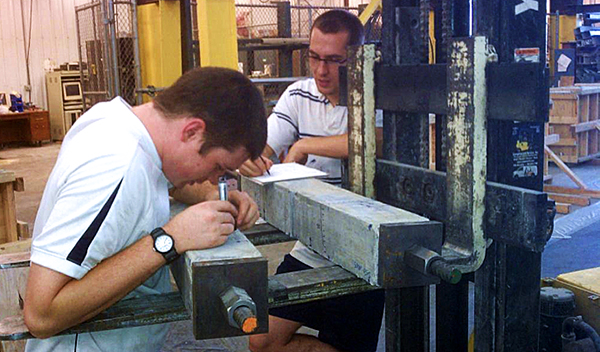
From left: Researchers Gun Kim, Chiwon In, and Katie Matlack.
While it’s known that some cracks in concrete can “self-heal”, before now it wasn’t possible to monitor the extent of self-healing occurring below the surface. Former CEEatGT graduate program students Chiwon In, Ph.D. and R. Brett Holland, Ph.D. collaborated with School Professors Kimberly E. Kurtis, Ph.D.; Lawrence F. Kahn, Ph.D.; Laurence J. Jacobs, Ph.D.; and Georgia Tech civil engineering Senior Research Engineer Jin-Yeon Kim, Ph.D. on the research effort which explores a new method for measuring self-healing of concrete cracks in damp and aqueous environments.
That effort resulted in a peer-reviewed paper, “Monitoring and evaluation of self-healing in concrete using diffuse ultrasound", published in the July 2013 issue of Nondestructive Testing and Evaluation (NDT&E) International. Recently, NDT&E highlighted the team’s paper by selecting it for a special virtual issue on “Civil Structures and Materials”. The team’s paper was one of nine chosen for the special issue and was the only contribution using ultrasonics.

Photo courtesy Flickr user portoftacoma.
The study measured the progression of autogenous healing, or self-healing, of cracked concrete. Self-healing is an inherent process of concrete crack repair that occurs when there is both moisture present and tensile stress absent from an environment, such as in a marine setting. At a microscopic level, self-healing happens due to a combination of mechanical blocking by particles carried into a crack, along with the filling of the crack by calcium carbonate deposits, derived from hydration products within the concrete itself. The natural process can aid in closing relatively narrow dormant cracks.

Graduate students taking crack width measurements before sealing and exposure.
Measurements in the study were conducted on cracked and un-cracked concrete specimens of three different mix designs before specimens were exposed to a simulated marine environment for four months. Then, measurements were taken again using the two diffuse ultrasonic parameters: the researcher’s novel application of the effective diffusivity, as well as an arrival time of maximum energy (ATME) measure.
The researchers found that with the progress of self-healing, the ATME of both tensile and flexure cracked specimens decreased, while the diffusivity increased. They also recovered the initial values found in the un-cracked control specimens after self-healing. This suggested not only self-healing of the cracks, but that the diffusivity method predicted self-healing trends in a more effective way than the ATME method.
The researchers concluded that the present diffuse ultrasonic method is capable of monitoring and evaluating the self-healing of concrete, citing that the ATME is not necessarily proportional to the crack depth, and, that therefore, ATME values will strongly depend on where on the crack face self-healing occurs.
You can read more about the team’s findings in the Independent Nondestructive Testing and Evaluation (NDT&E) International virtual issue, and read the paper in full via Science Direct.
